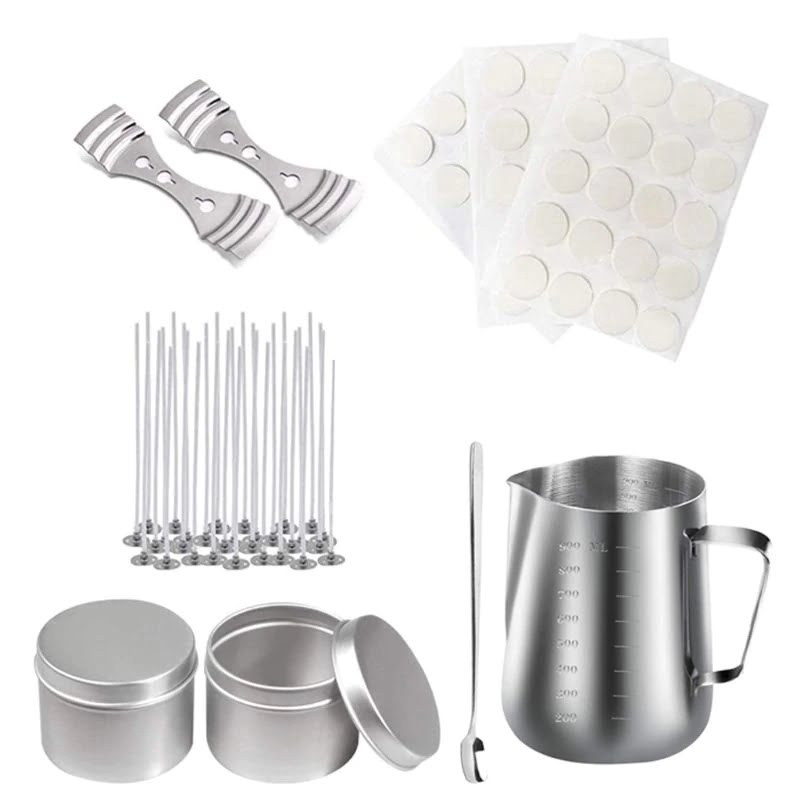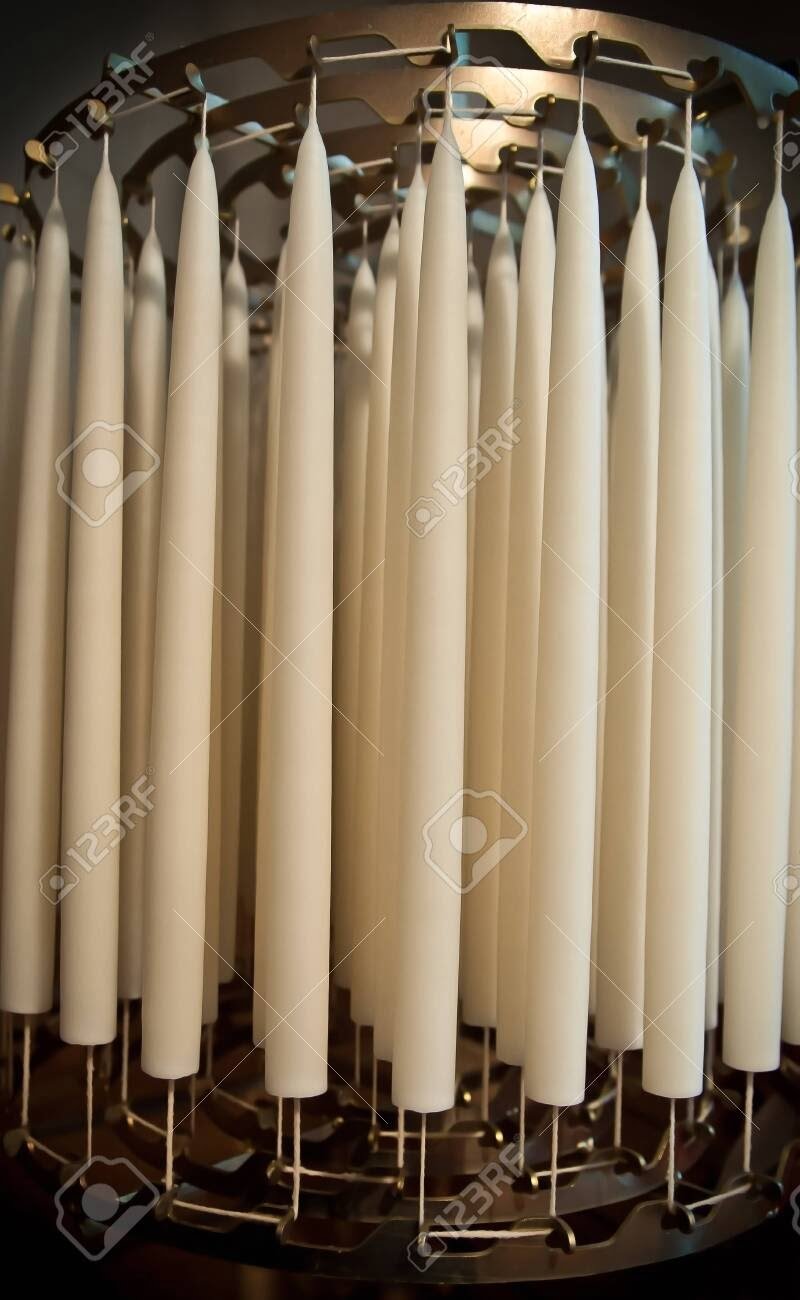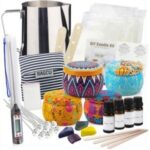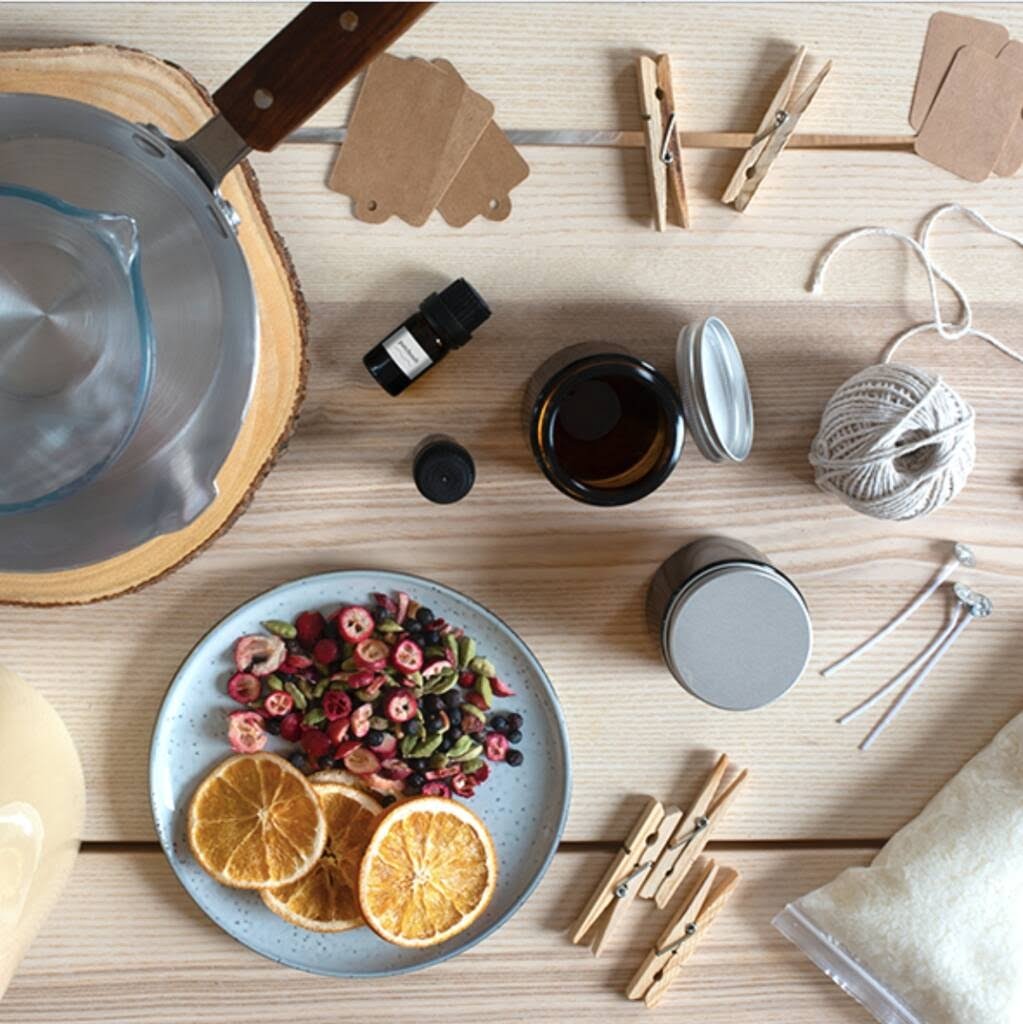Introduction
Creating fragrant candles is an easy and fun DIY project that you can do at home. Making your own fragrant candles gives you control over the scent, strength, and appearance of the finished product. Whether you’re looking to fill your home with a light floral aroma or something more on the smoky spectrum, handmade scented candles can add the perfect finishing touch to any room. With some basic tools and supplies, you can craft unique and beautiful candles that will become a staple of your decor in no time.
This guide will provide step by step instructions on how to make fragrant candles as well as tips for selecting waxes, wicks, molds, colors and essential oils to create personalized aromas. We’ll also discuss different types of candles and offer insight into troubleshooting common mistakes made during candle-making so that you have the best chance of success. Finally, we’ll review safety measures while crafting these luscious smelling pieces of art. So let’s get started!
To make fragrant candles, you will need: candle wax (either paraffin or soy wax), wick bases, essential oils or candles scents for fragrance (or both!), thermometer for measuring temperatures of wax during melting process; color dye/pigment to colour the wax; melt-and-pour soap base; molds in which to pour hot liquid wax; ziplock bags (optional); oven mitts (for handling hot materials). Additionally, it is helpful to have a few spoonfuls of table salt handy in case there are bubbles forming while pouring the melted wax into molds ” this tends to help reduce bubble formation. It’s also beneficial to have a hair dryer or heat gun on hand; these two items can be used for melting small awkward areas where traditional melting methods may not work as well.
In terms of selecting the right supplies for making fragrant candles, there are many factors that should be taken into consideration when shopping for materials including but not limited to: type/formulation of candle wax being used (paraffin versus soy), type/size/shape of wick being used (cored versus tabbed), type/strength of fragrance or essential oil being used (for scented versions), and finally type/shape/material used for mold in which poured liquid wax will be cooled inside before being removed from its casing after solidifying into finished candle form.
What You Need to Get Started
Types of Wax: For candle making, you have many options for wax types. Paraffin wax is the oldest and still one of the most popular choices due to its low cost and accessibility. Soy, palm and beeswax are also increasingly popular nowadays. Each type has different melting points and properties that result in different qualities once the candle is finished. Therefore, after deciding on what type of wax you would like to use, it is important to research each variety and keep in mind that their characteristics will affect the end product.
Fragrance: There are two main ways to scent a candle: with fragrances or essential oils. Fragrances are available both as natural extracts and artificial compounds. Essential oils are highly concentrated and if used on their own can create a very distinctive scent depending on the type (e.g lavender, rose etc). They can be used alone or in combination with other oils for a more complex scent profile. Whichever one you choose for your candles, make sure to get 100 percent pure and safe products from reputable vendors.
Wicks: Wicks should match the type of wax that you’ve chosen” not all wicks work perfectly well on all types of waxes, so it’s important to research this part as well for best results. Make sure that the wick is wide enough to handle your candle’s size properly but small enough so as not too produce too much flame”you do not want it go out! It’s worth testing several sizes before settling into final choice(s)
Color: Finally, color affects both how people perceive a candle’s aroma and how long the burning duration lasts. Many beginners skips color altogether which is ok; however note that if you want them to look interesting adding color will make an excellent addition either via powdered pigments or liquid dyes made specifically for candles. These come in vast array of colors allowing lots of creativity when making your own candles at home!
Choosing the Right Wax for Fragrant Candles
The type of wax used to make fragrant candles has a lot to do with their overall performance and ability to emit beautiful aromas. Paraffin wax is the most common type used for candle making and it produces excellent glass adhesion. However, there are other types of wax that can also be used. Soy wax is an increasingly popular alternative that many candle makers prefer because it is derived from a vegetable source and it holds fragrance better than paraffin. Coconut wax blends, beeswax, and gel wax are some of the other options available as well. Each type of wax has its own unique traits so it’s important to choose the one best suited for your needs, such as with the desired burn rate or thickness of the walls of the finished product. Whichever type you decide on, make sure you read through all product warnings before getting started ” this is especially true when working with soy and beeswax, which have potentially flammable flash points and must be melted carefully.
Understanding the Science of Candle-Making
Making candles at home can be a fun activity that allows you to create beautiful and fragrant pieces. But when it comes to making truly great candles, it’s important to understand the science behind candle-making. Candle-making is essentially a chemical reaction between the wax and the wick.
When heated, wax molecules break apart until their atom groups turn into vaporized gases. This releases fragrance molecules into the air and provides a soothing aroma throughout your home. Depending on which type of wax is used, the rate of this burning process may vary from slow and steady when using natural beeswax, or quick and intense with paraffin wax.
The wick also plays an important role in candle-making. Cored wicks are made of several threads woven together that are then surrounded by an outer core of zinc, tin or other metals which wire together and provide additional support for burning. These wicks also help control the combustion rate of the mixture until all of the fuel has been consumed by the heat released from burning. Thicker wicks will burn slower and cause less smoke as compared to thinner ones, allowing for larger flames and more intense scents to be released from your candles over longer periods of time.
Adding fragrance oils is what makes any candle smell pleasant while helping disperse some of these oils into the surrounding air. Most fragrances are composed of essential oil blends combined with alcohols or carrier oils such as coconut oil or jojoba oil so they won’t evaporate too quickly into thin air after burning has begun. Adding anywhere from 5-10% weight to volume ratio of carrier oil should provide enough fragrance notes needed for scenting your candles long after they’ve burned out completely.
Preparing the Wax for Pouring
Before you begin pouring the wax, it is essential that you prepare the wax correctly. Start by heating and melting the desired amount of wax in a double boiler. Once the wax is completely melted, add in the desired scent according to packaging instructions. When adding scent, mix gently to avoid air bubbles forming on your candle surface. Add in any other additives such as color or glitter at this stage if desired. Before pouring, measure the desired temperature of the wax using a thermometer and adjust accordingly depending on what type of candle is being poured. For instance, a softer wax should be cooled to 120-130 degrees F before pouring and a harder wax should be heated to 160-170 degrees F. Lastly, test a few drops of prepped wax seed into a container to confirm it meets expectation and behaves correctly once hardened before full-speed pouring commences!
Fragrance Selection for a Lively Aroma
When choosing your fragrance for a candle, there are various factors to consider in order to get the perfect desired result. You want to choose a fragrance that will provide a lively atmosphere in any room. Light, floral or citrus scents can be used for small spaces whereas heavier options such as woodsy or sweet fragrances work better in larger areas. Experimenting with different combinations of these two categories of scent can create unique, creative blends that can bring a wonderful feeling of intimacy and coziness into any living space. Essential oils also offer unique fragrances that can produce an even more intense aroma. Often, these combine well with other scents and are great for providing refreshing air flow in hot summer months or adding warmth and energy in the colder winter months. Lastly, don’t forget to keep the season in mind when deciding on a scent. A mixture of apple cider and cinnamon during autumn can have wonderful inviting effects, while lavender and jasmine work perfectly during summer days or evenings. Ultimately, choose something personal — finding the right combination can make all the difference!
Adding Color to Enhance Your Candles
Coloring your candles can help them stand out and really grab attention. Make sure to buy dye that is made specifically for wax, so you don’t end up with a poor-looking candle. With the right dyes and tools, you can create anything from bright primary colors to soft pastels. Just remember not to add too much dye or your candle might become brittle. Adding color also works well for highlighting scents; for example, using a light blue hue with a lemon scent will make the fragrance really “pop”. To ensure the even distribution of color throughout the whole candle, it helps to heat up the wax before adding any dyes, stirring them in as you go. This method will help avoid streaks and/or strange patterns within the candle itself. Don’t be afraid to experiment with coloring candles”with a bit of trial and error, you can create something truly unique!
Inserting Wicks to Keep Your Candles Burning Bright
Inserting wicks into your candles is a crucial step in the candle-making process. Doing so in the correct manner ensures that your candles will burn steadily and consistently for many hours, delivering a beautiful and fragrant aroma. To insert wicks into your handcrafted candles, begin by measuring how much extra wax is needed to keep the wick erect when melted. Mark out this area of the container with a pencil and then use a wick tab or washer to allow secure access to the center of the candle. Place the top of the wick tab or washer into this inner space and make sure it doesn’t touch the sides of its container. Use scissors or a glue gun to attach securely so that when you pour in melted wax, it remains fixed firmly in place at all times. The next step is to add hot-glue around one end of each cut-out length of wick and fix them to the tab,. Leave around an inch of slack between each wick so that they don’t catch on fire while they burn away. Lastly, pour in fragile hot wax while maintaining a high temperature until it reaches just below last marked line from earlier. Now you will have successfully created lovely scented candles with perfect burning wicks!
Heating & Pouring the Wax to Produce the Perfect Candles
Making fragrant candles is a relatively simple process that anyone can accomplish with the right ingredients and equipment. To begin, you will need a wax melting pot to heat the wax, thermometer to monitor the temperature of the wax, and a container for the finished candle. You will also need to have purchased or made molds for your candles if you wish to use them. When selecting wax for your candles, opting for one that contains some form of bee’s wax or soy will help your candle burn better in addition to adding to its scent.
Once all materials are gathered and ready, it’s time to get started! Begin by heating the wax in a melting pot over medium heat on your stovetop according to any instructions provided with your particular type of wax. While melting, be sure to keep an eye on the temperature of the wax using a thermometer, as too high or low of a temperature can affect how long your candles burn and smell when lit. Once the correct temperature is achieved (usually around 145°F), it’s time to add essential oils, color dye, and fragrance into the melted wax. After stirring everything together uniformly so all ingredients blend nicely, turn off the heat and start carefully pouring hot liquid wax into pre-made molds or containers, making sure not to overfill them but fill all pieces just enough that there is no air at their tops once cool. Finally, after about 30 minutes let cool then voila you now have perfectly seasoned homemade fragrant candles!
Safety Tips for Making Fragrant Candles
When making fragrant candles, always practice safety first. Start by ensuring that you are working in a well-ventilated area and away from open flame and sources of heat. Wear protective glasses to protect your eyes, as well as an oven mitt or protective heating pad to protect your hands and arms when handling heated wax.
Additionally, make sure that you have all of the necessary supplies on hand before beginning the project to avoid potential injury or damage. These supplies may include wax, wicks, double boiler pots, thermometers, containers (such as glass jars), fragrance oil, wick holders and clamps or a glue gun with glue sticks. It is also important to read the instructions carefully on any product that you choose to use before getting started.
If you plan on creating multiple candles at one time, it is best to stick with one specific type at a time for consistent results. When working with hot materials such as wax, especially for the first time, it is wise to work in small batches until you have mastered techniques such as creating the desired shape or adding scents. This will help you become more familiar with the process and reduce the risk of accidental spills and fires that can occur depending on ingredients used.
When mixing oils into wax be sure not to introduce them until wax has cooled enough to handle safely without protection. As a rule of thumb never add essential oils when they are at room temperature; instead pre-dilute them in vegetable oil prior to introducing them into cooling wax sofety gloves should be worn during this process incase of any accidental splashesoccuring while mixing molten materials togethers A teaspoon can be used beneath spout of measuring cup while including scents in order to ensure a steady flow and reduced mess around pouring area Finally ensure any containers used has been cleansed prior to using them for preventing any potential contamination which can be hazardous when longterm storaged envisaged Finally becarful disposal of wax remnants which have cooled completely should always be practised afterwards it is adviced these are disposed offin sealed plastic bags for added protection
Finishing Touches to Make Your Candles Shine
Once your candles are finished, there are a few final touches you can take to make them shine. To start with, you can choose to add decorative items such as glitter, beads or sequins. This will give your candles added sparkle and visual appeal. You can also use fragrance oils or scented extracts to enrich the scent of the candle so it creates an inviting aroma when burning. When adding fragrances, be sure to do so sparingly – too much oil may cause the wick to smoke or fail to burn properly. Lastly, wrap your candles in ribbon for a polished look and ensure they are stored away from direct sunlight and high temperatures so that their perfect homemade look is preserved for a long time.
Packaging & Labeling Ideas for Professional Presentation
When making fragrant candles for a professional presentation, it is important to consider the packaging and labeling. If a label is used, it should be designed to reflect the quality of your product. For example, use high-quality paper stock and include all relevant information such as the name of your company, ingredients used in making the candle and any other necessary details. Additionally, make sure to clearly display any warnings associated with burning the candle safely.
Another idea for packaging is to use an eco-friendly option such as recyclable or reusable material. This will help to ensure that your product looks professional when presented to customers and can help reduce both cost and waste for your business. It also shows potential customers that you are committed to being eco-friendly and care about the environment.
Labeling should also be considered when creating fragrant candles for a professional presentation. Labels should match the overall theme of the presentation so that it looks thoughtfully put together from start to finish. You may want to look into having custom labels made with beautiful artwork or imagery related to your candles’ scent if you wish to make a lasting impression on potential customers.
In addition, using a scented hangtag can help differentiate your products from competitors’ goods while providing customers with an accurate representation of what they are buying without needing them to open up the branding portion of their item’s packaging – this saves time and reduces mess during pre-sale inspection! Finally, don’t forget social media! Utilizing Instagram or other platforms is an excellent way to effectively market your fragrant candles directly towards potential customers through attractive visuals displayed with short captions that communicate what makes each scent unique.
Conclusion
Making fragrant candles is a great way to bring a feeling of warmth and relaxation into your home. The simple process of transforming natural wax, essential oils, and wicks into something special is incredibly rewarding. Start by gathering all the supplies needed to make your candles. Make sure to pick waxes that will hold the scent well and select essential oils that you enjoy. Then carefully melt the wax, add in the essential oils (avoiding skin contact with any hot wax or oils), pour it into containers, insert wicks, and let cool before trimming the wick. Finally, light your creation to fill your home with an inviting aroma! With just a few ingredients, you can turn an ordinary activity into a delightful routine enjoyed by everyone. Create beautiful scents that enhance the atmosphere of any room by bringing out the magic of fragrant candles.

Welcome to my candle making blog! In this blog, I will be sharing my tips and tricks for making candles. I will also be sharing some of my favorite recipes.





